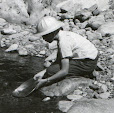As you may recall from a previous post, last March the governor signed S.B. 6343 establishing a pilot program to allow small scale prospecting and mining on Washington's ocean beaches beginning July 1, 2008.
Thanks to the kindness of Lisa Lantz, Resource Stewardship Manager for the SW Region of Washington State Parks, who supplied a copy of an update report prepared for the Parks Commission on January 22 last, we now have some insight on what has been happening behind the scenes.
According to the report, beginning in May, 2008, State Parks personnel met with WDFW and selected three areas where prospecting would be allowed: "Long Beach – from Ocean Park Ocean Beach Access (OBA) to Klipsan OBA; South Beach – from Bonge OBA to Grayland OBA; and North Beach – from Ocean City OBA to Oyehut OBA."
Subsequently, State Parks received comments that the prospecting areas selected failed to provide freshwater access for miners. As a result, State Parks, in consultation with WDFW, "opened the Iron Springs area, a one-half mile stretch of North Beach, centered on the mouth of Boone Creek," in December.
It should be noted that all participants in the pilot project are required to obtain an HPA from WDFW. Information on applying for an HPA is available from the WDFW web page here. On-line forms and instructions may be found at the One-Stop JARPA Resource Center.
Originally, WDFW limited the equipment miners could use to "motorized pans, non-motorized pans, sluice boxes, mini rocker boxes and non-motorized concentrators." This list was subsequently expanded to include:
Pans; Spiral wheels; Sluices, concentrators, mini rocker boxes, rocker boxes, mini high-bankers with riffle areas totaling 3 square feet or less, including ganged equipment, and high-bankers with riffle areas totaling 10 square feet or less, including ganged equipment; Suction dredges with suction intake nozzle inside diameters no greater than 5-1/4 inches. The inside diameter of the dredge hose attached to the nozzle may be no greater than one inch larger than the suction intake nozzle size; Power sluice/suction dredge combinations with riffle areas totaling 10 square feet or less, including ganged equipment; suction intake nozzle inside diameters no greater than 5-1/4 inches; and pump intake hose inside diameters no greater than 4 inches. The inside diameter of the dredge hose attached to the suction intake nozzle may be no greater than one inch larger than the suction intake nozzle size; and, High-bankers and power sluices with riffle areas totaling 10 square feet or less, including ganged equipment, and pump intake hoses with inside diameters of 4 inches or less.
Furthermore, when miners receive their HPAs, they "also receive maps of the pilot areas and a letter from Parks requesting their cooperation in collecting basic information on the pilot project," including, "where each mining activity occurs, the number of people participating, number of days per activity, quantity of material removed from the beach, type of equipment used, and any difficulties encountered." Miners are also required to "notify WDFW and Parks staff prior to starting work."
According to the report, as of December, 48 people had registered in the North Beach area. The other areas had no reported activity.
For those interested in reading it, the update report for the Parks Commission is available the the link below:
Placer Mining Pilot Program Report.pdf
Subscribe to:
Post Comments (Atom)

No comments:
Post a Comment